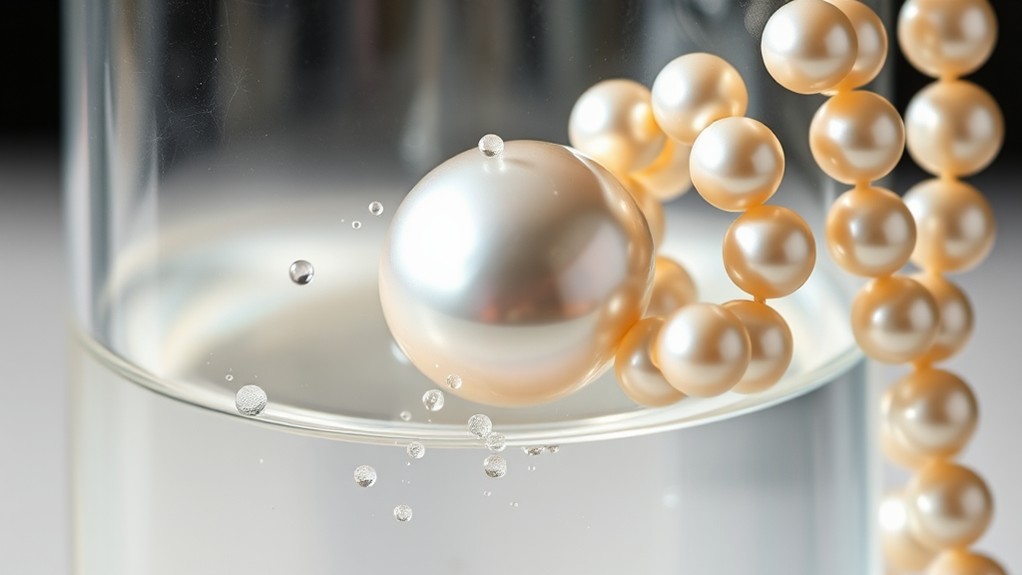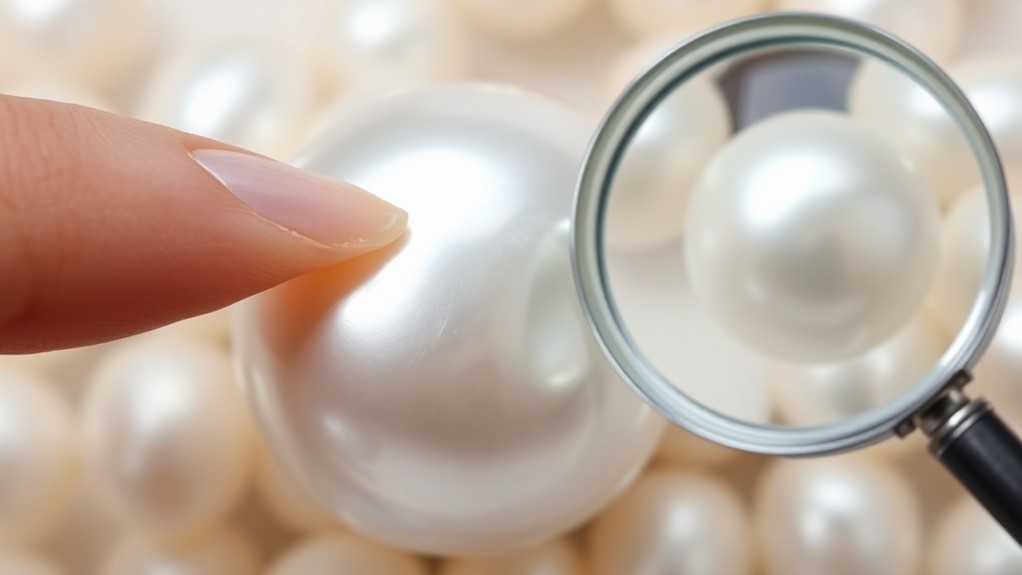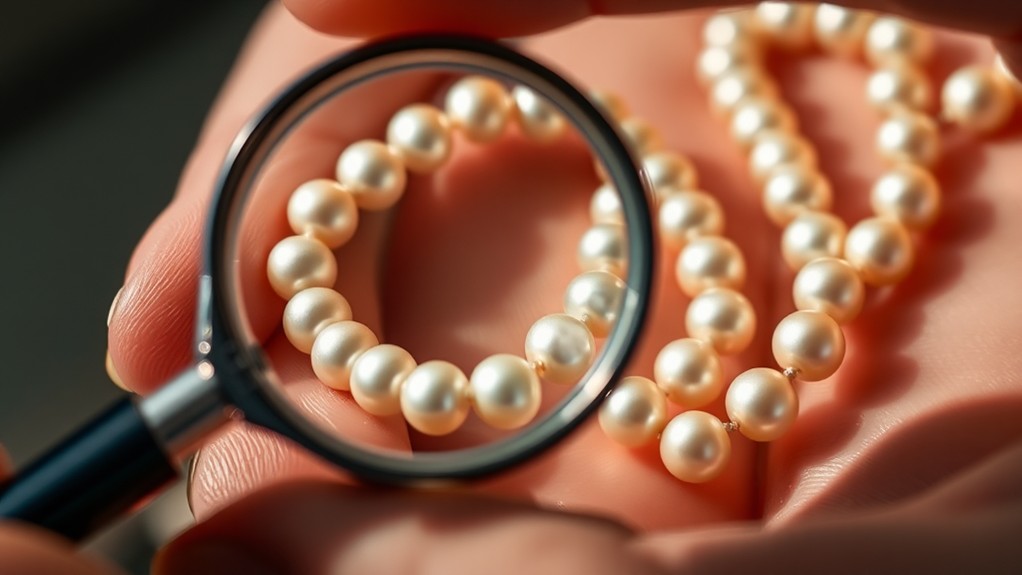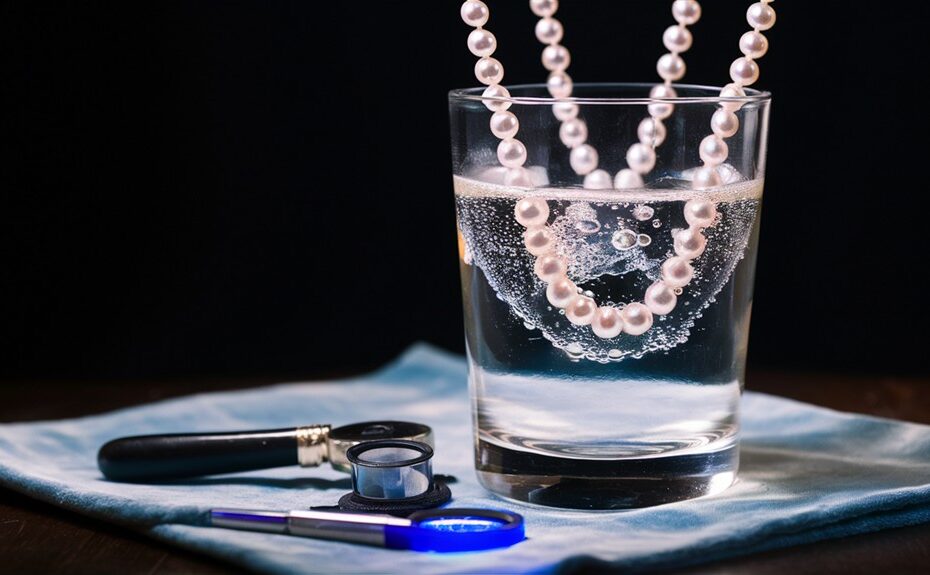You've just acquired a stunning pearl necklace, but how can you be sure it's the real deal? Pearl authentication is an essential skill for jewelry enthusiasts and collectors alike. While the vinegar test is a well-known method, it's not without controversy. There are several other techniques you can employ to verify your pearls' authenticity, ranging from simple at-home tests to advanced laboratory procedures. Understanding these methods will not only help you protect your investment but also enhance your appreciation for these oceanic gems. Let's investigate the world of pearl authentication and uncover the secrets behind these lustrous treasures.
Our Highlighted Points
- Visual inspection techniques assess surface characteristics, luster, shape, and drill holes to distinguish real pearls from imitations.
- The vinegar test, though controversial, can reveal authenticity through a chemical reaction with nacre layers in real pearls.
- The tooth test method provides instant results by comparing the gritty texture of real pearls against the smooth feel of fakes.
- Advanced laboratory testing options include X-ray examinations, specific gravity tests, and X-ray fluorescence analysis for definitive authentication.
- Purchasing from reputable sources with certifications and return policies reduces the risk of acquiring counterfeit pearls.
The Vinegar Test Explained

The vinegar test is a controversial method used to distinguish real pearls from fake ones. This technique relies on the chemical reaction between vinegar and the nacre layers present in authentic pearls. When you apply vinegar to the surface of the pearl, real pearls will show signs of erosion or dissolution, while imitation pearls remain unaffected.
To perform the vinegar test:
- Obtain undiluted vinegar for faster results
- Place a drop of vinegar on the pearl's surface
- Observe the reaction for several minutes
It's vital to understand that this test can potentially damage authentic pearls, making it less recommended for routine pearl authenticity checks. The effectiveness of the vinegar test increases with the concentration of the vinegar used.
However, because of its potentially destructive nature, many experts prefer non-destructive methods for verifying pearl authenticity.
Alternative techniques, such as the friction test, offer a safer approach to assessing pearl authenticity. These non-destructive methods preserve the integrity of the pearl while still providing valuable information about its composition.
When considering pearl authentication, it's important to weigh the risks and benefits of each method to guarantee the best outcome for your valuable jewelry.
Visual Inspection Techniques
Identifying authentic pearls often begins with a careful visual inspection. To tell if a pearl is real, you'll need to examine its surface characteristics closely. Real pearls typically display subtle imperfections and color variations, reflecting their natural formation. In contrast, fake pearls often appear flawless with uniform coloration.
When inspecting pearls, pay attention to:
- Surface texture: Genuine pearls feel slightly gritty, while imitations feel smooth.
- Luster: Authentic pearls exhibit a deep, dimensional glow, unlike the flat shine of fakes.
- Shape and size: Natural pearls vary in shape and size, whereas imitations are often perfectly round and uniform.
- Drill holes: Examine the edges around the drill holes; real pearls have sharp, well-defined edges.
Your inspection may reveal layers of nacre in authentic pearls, visible as depth and complexity in their luster. Use a magnifying glass to observe these subtle details more closely.
The Tooth Test Method

Among the simplest yet effective methods for pearl authentication, the Tooth Test stands out. This technique involves gently rubbing a pearl against your tooth to assess its authenticity. Real pearls feel gritty or slightly rough, while fake pearls feel smooth and glassy. The test provides instant results without damaging the pearl, making it a practical choice for quick assessments.
To perform the Tooth Test:
- Clean the pearl and your tooth thoroughly.
- Lightly rub the pearl against the flat surface of your front tooth.
- Analyze the sensation: a gritty feel indicates a real pearl, while a smooth feel suggests a fake.
However, be aware that some modern fake pearls may have coatings that replicate the gritty texture of real pearls, potentially misleading you.
As an alternative, you can use the friction test:
- Rub two pearls together or against glass.
- Real pearls will produce a gritty feel and may leave iridescent powder.
- Fake pearls will glide smoothly.
While the Tooth Test is effective, hygiene concerns may limit its use in jewelry shops. In these cases, the friction test is often preferred.
Weight and Temperature Assessment
While visual inspection can be deceiving, assessing a pearl's weight and temperature offers valuable clues about its authenticity.
Real pearls typically exhibit distinct characteristics that set them apart from their imitation counterparts:
Weight Test:
- Place the pearl in your palm.
- Gauge its weight relative to its size.
- Real pearls feel heavier because of their dense composition.
- Imitation pearls often feel surprisingly light.
Temperature Assessment:
- Preliminary touch: Real pearls feel cooler than imitations.
- Hold the pearl for a few moments.
- Authentic pearls warm up slowly.
- Synthetic pearls maintain a consistent temperature.
Combining these tests can provide a reliable initial indication of a pearl's authenticity:
- Start with the temperature test.
- Follow with the weight assessment.
- Compare results to expected characteristics.
Real pearls should:
- Feel cool at first touch.
- Warm gradually in your hand.
- Have a weight that feels substantial for their size.
Imitation pearls often:
- Feel warm immediately.
- Maintain a consistent temperature.
- Seem lighter than expected.
Luster and Surface Examination

Examining a pearl's luster and surface offers essential insights into its authenticity. When assessing luster, focus on the depth and quality of the reflective shine. Genuine pearls exhibit a three-dimensional, deep luster that's challenging to replicate in imitations. Surface examination is just as important; real pearls often display minor imperfections like bumps and ridges, while fake pearls tend to be uniformly smooth.
Pay close attention to color variations and overtones. High-quality, genuine pearls showcase subtle hints of color on their surface, adding depth and character. Imitation pearls, conversely, often lack these intricate color variations, presenting a uniform appearance throughout.
Inspect the drill holes carefully, as they can reveal telltale signs of authenticity:
| Feature | Genuine Pearls | Imitation Pearls |
|---|---|---|
| Luster | Deep, 3D shine | Flat or overly shiny |
| Surface | Minor imperfections | Smooth, uniform |
| Color | Subtle variations | Consistent throughout |
| Overtones | Present | Usually absent |
| Drill holes | Clean, well-defined | Rough or rounded edges |
Drill Hole Inspection
Drill hole inspection provides a unique window into a pearl's authenticity. When examining a pearl's drill holes, you'll want to focus on several key aspects that can reveal its true nature:
- Edge quality: Authentic pearls exhibit smooth, well-defined edges around their drill holes, indicative of layered nacre. In contrast, imitation pearls often display rough or rounded edges owing to inferior manufacturing processes.
- Nacre layers: Genuine pearls typically show visible layers of nacre within the drill holes, while fake pearls lack this feature and may appear solid throughout.
- Hole consistency: High-quality, authentic pearls have clean, consistent drill holes. Imitations may show signs of chipping or paint around the edges.
- Hole depth: Real pearls usually have deeper drill holes to accommodate their layered structure, whereas fakes often have shallow holes.
To properly inspect drill holes, use a magnifying glass or jeweler's loupe. This will allow you to detect irregularities that suggest authenticity versus imitation.
Advanced Laboratory Testing Options

For the most definitive pearl authentication, advanced laboratory testing options offer unparalleled accuracy.
X-ray examination reveals the layered nacre structure of genuine pearls, while synthetic pearls appear solid throughout. This method provides conclusive evidence of a pearl's authenticity.
Specific gravity tests measure density, with real pearls typically exhibiting higher density than imitations.
X-ray fluorescence analysis examines the elemental composition of pearls, offering insights into their authenticity based on the presence of natural materials.
Professional appraisals conducted by certified gemologists often include a combination of these advanced tests and visual inspections to guarantee accurate identification.
When seeking advanced laboratory testing for pearl authentication, consider the following:
- X-ray examination for internal structure analysis
- Specific gravity tests for density measurement
- X-ray fluorescence for elemental composition analysis
Obtaining a formal appraisal not only validates the authenticity of high-value pearls but likewise provides documentation useful for insurance or resale purposes.
By utilizing these advanced techniques, you'll gain a thorough understanding of your pearl's authenticity, composition, and value.
Keep in mind that professional gemologists are best equipped to perform these tests and interpret the results accurately.
Purchasing From Reputable Sources
One of the most reliable ways to confirm you're getting authentic pearls is by purchasing from reputable sources. When buying pearls, seek out sellers with established industry reputations, such as Pearls of Joy, who directly source from pearl farms.
These reputable sellers often provide:
- Return policies allowing customers to return pearls if authenticity doubts arise
- Certifications from recognized gemological institutions
- Extensive information about pearl characteristics and care
To ascertain you're dealing with a trustworthy vendor:
- Research customer testimonials and reviews
- Look for sellers with a large base of satisfied customers (e.g., Pearls of Joy's 40,000+ happy clients)
- Verify the seller's certifications and credentials
By choosing a reputable source, you greatly reduce the risk of acquiring counterfeit products.
These sellers prioritize pearls authenticity and the quality of products, offering expert guidance throughout your purchase. Their commitment to transparency and customer satisfaction improves your general buying experience and confidence in your pearl acquisition.
Frequently Asked Questions
How Do You Test Pearls With Vinegar?
You can test pearls with vinegar by placing a drop on the pearl's surface. If it's real, you'll see bubbling or erosion. However, this method isn't recommended as it can damage genuine pearls. Consider safer alternatives instead.
What Is the Easiest Way to Tell if a Pearl Is Real?
You can easily determine if a pearl's real by rubbing it against your tooth. If it feels gritty, it's likely genuine. If it's smooth, it's probably fake. This simple "tooth test" is quick and reliable.
How to Tell a Real Pearl From a Fake One With a Magnet?
To use a magnet to tell if a pearl's real, you'll need a strong magnet. Hold it close to the pearl. If it's attracted, it's fake. Real pearls aren't magnetic. Remember, this test isn't foolproof alone.
How Do You Evaluate a Pearl Necklace?
To evaluate a pearl necklace, you'll want to check its weight, surface texture, and luster. Rub the pearls together to feel for grittiness. Examine drill holes and look for natural imperfections. Assess the pearls' general color and overtones.


